| » Diyar Diyar Anadolu |
 Doğal Yaşam Doğal Yaşam |
 İl İl Türkiye İl İl Türkiye |
 Kültürel Miraslarımız Kültürel Miraslarımız |
| |
|
| |
| » Fotoğrafça | Site Yöneticileri Uyuyor Mu?
|  Merhaba Arkadaşlar, Sürekli eleştiriliyoruz. Taktir edilsek de genel de bu niye yok, şu niye eksik, onay niye geç gibi bir dolu sorunun muhatabı oluyoruz. Siteyle ilgili olarak bir çok konu açıldığı gibi birçok da e-mail alıyoruz. Bunların bir kısmına cevap verdiğimiz gibi b... Merhaba Arkadaşlar, Sürekli eleştiriliyoruz. Taktir edilsek de genel de bu niye yok, şu niye eksik, onay niye geç gibi bir dolu sorunun muhatabı oluyoruz. Siteyle ilgili olarak bir çok konu açıldığı gibi birçok da e-mail alıyoruz. Bunların bir kısmına cevap verdiğimiz gibi b... | | Devamı » |
| |
| » İl İl Türkiye |  | | Tarsus | | Aksaray'ı geçtiğiniz zaman Toros'ların serin rüzgârı karşılar önce sizi. İçinize işler, titretir yeli, içinizden çok çenenizi.
Gülek'ten aşağı salla... | | Devamı>>> |
| |
| » Aktif Üye/Ziyaretçi |
| Üye: sezgin72,
sxs,
(2)
|
|
| Ziyaretçi: |
| |
| Toplam Üye: 283052 | | Dün: 0 | | Bugün: 0 |
|
|
|
Ağrı Ishak Pasha Palace - Doğubeyazıt / Ağrı |
İshak Pasha Palace is more of a complex than a mere palace. It is our second administrative campus after the Topkapı Palace in İstanbul and the most famous of the palaces built at recent decades.
The palace which was built on a hilla at the side of a mountain 5 km east of Doğubeyazıt District is the last large monumental structure of the Ottoman Empire in the "Lale Devri" period. It is one of the most distinguished and magnificent examples ofthe 18th century Ottoman architecture and is very valuable in terms of art history. According to the top of the door inscription at the Harem Section it was consstructed in 1784 or 1199 accordingto the Islamic calendar.
As the ground building sits on is a valley slope, it is rocky and hard. Despite the fact that it is at the center of the Old Beyazıt city its three sides (north, west, south) are steep and sloped. There is a suitable flat area only to the east. The entrance of the palace is on that side. Its also its narrowest facade.
As the palace was built inan age when the castles ceased to be special and fire arms were developed and were abundently available its defense towards the hills on the east is weak. Its main gate is the weakest point in that respect. The structure of the main gate is no different than those seen in the palaces built in İstanbul and elsewhere in Anatolia and has a neat stone workmanship and carving.
Today we have very few examples of the historical Turkish palaces still surviving. One of these is the İshak Pasha Palace and complex.
Ishak Pasha Palace is composed of following sections in terms of architectural style:
1- Exterior facades
2- First and second courts
3- The men's quarter (selamlık)
4- The mosque building
5- The Soup Kitchen (Darüzziyafe)
6- Bath
7- Rooms of the Harem Section
8- Hall for ceremonies and entertaintment
9- Arch gates
10- Panteries and ammunition room
11- The mousoleum
12- The bakery
13- Dungeons
14- Some sections from interior design (doors, windows, cupboards, fireplaces, soft drink cupboard etc)
The characteristic of the palace is in its mixture of Ottoman, Persian and Seljuk architectural styles. The palace was built in 1685 by II. İshakpaşa of the Çildıroğulları and Çolak Abdi Pasha and took its final form in 1784. The building occupies an area of approximately 115m x 50 m. The portal on the eastern facade of the palace, which is built with cut stones, reflects the characteritics of the Seljuk art with its reliefs and decorations.
The palace is composed of two courts and the collection of structures positioned around them. Some of the buildings of the first court are destoyed. The second court which is surrounded on four sides with buildings has a rectengular plan. To the right, with reference to the entrance there is the men's quarter and behind it the harem section. At the end of these, there is the mosque and the mousoleum. The mousoleum is built in the style of the Seljuk "kümbet" (cupola) architecture. The palace section has two stoerys. All of its 366 rooms are arranged on these two floors. Each room has a stone fireplace. The cavities within the stone walls indicate that the building as a whole possessed a central heating system.The reception hall is 30mx3 m. It has stone walls and floor . Its walls are decorated with couplets and verses from theKkoran in the decorative examples of the Turkish Chaligraphy art. Among these a couplet, which in very free translation goes like "Ishak, upon will, made the whole world a place of benovelence and the date to witness this was one thousand one hundred ninetynine" and indicates that the palace was completed in 1784 A.D. The mousoleum in the second court yard of the palace is built with cut stones This octoganal mousoleum is in the shape of the copolas, which is one of the most typical examples of the traditional Seljuk mousoleum architecture and has two storeys. Its walls are decorated with geometric motifs. Çolak Abdi Pasha, İshak Pasha and
|
| |
|